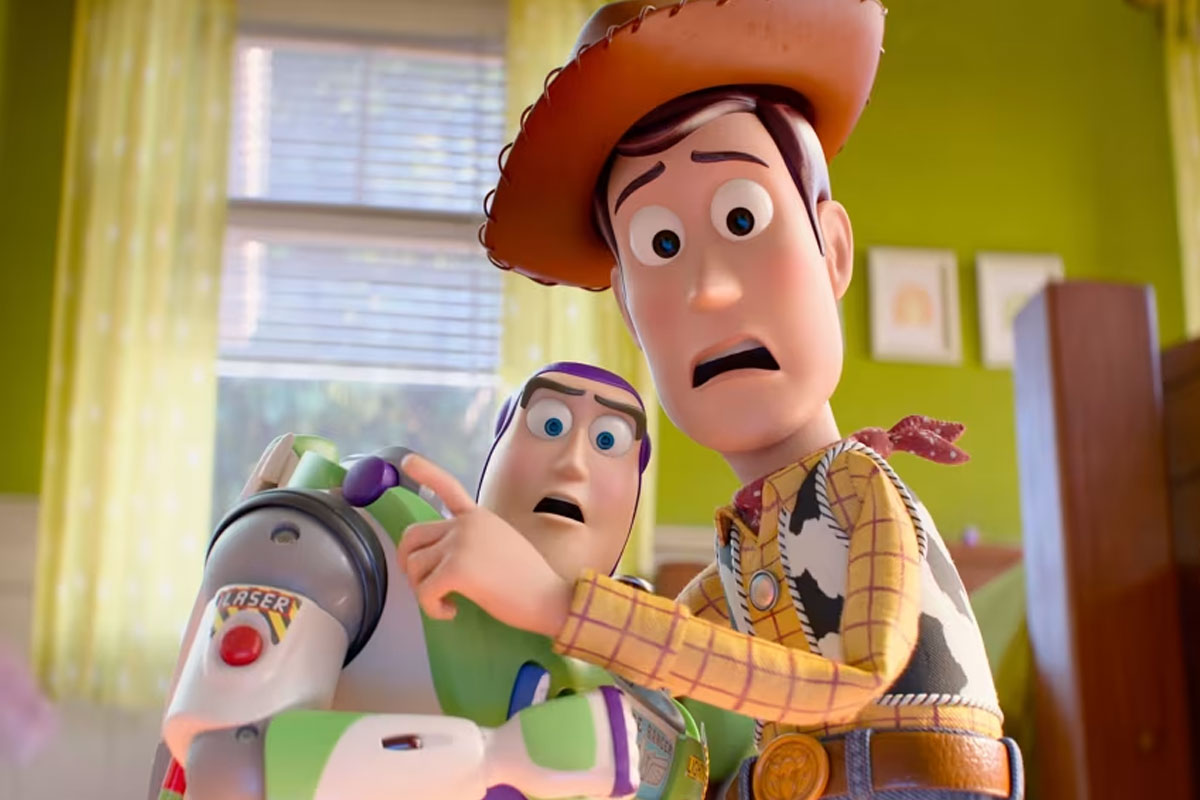The toys are back, but this time, their greatest threat isn’t a child growing up — it’s the screen in a child’s hand. Pixar has finally released the first teaser trailer for Toy Story 5, and it’s sending waves of nostalgia and curiosity across the internet. The short clip suggests a deeper, more emotional story that questions whether the golden age of toys can survive in a world dominated by digital playthings.
A New Challenge: Toys vs. Technology
The trailer opens with a familiar sight: Bonnie Anderson, the little girl who inherited Andy’s beloved toys at the end of Toy Story 3, receiving a mysterious package on her doorstep. Woody, Buzz Lightyear, Jessie, Rex, Slinky Dog, Hamm, and the Potato Heads peek out from their toy box, filled with the same mix of excitement and dread we’ve seen in earlier films.
As the box opens, the audience gets its first glimpse of the film’s new character — Lilypad, a sleek, frog-shaped smart tablet designed for children. With a cheerful electronic voice, Lilypad introduces itself, saying, “Let’s play!” The moment sparks both wonder and terror in Bonnie’s room — wonder for Bonnie, who immediately falls in love with her new gadget, and terror for the toys, who realize they may have just met their biggest rival yet.
This new digital addition to the Toy Story universe feels symbolic of our times. Where once toys feared being replaced by new favorites, now they face extinction at the hands of modern technology. The trailer closes with Woody’s somber voice asking, “If kids don’t play with toys anymore… what happens to us?”
Revisiting the Heart of Toy Story
From its debut in 1995, Toy Story has always been more than just a children’s movie. Each installment has explored profound emotional themes — identity, belonging, and the inevitable passage of time. The first film was about jealousy and friendship. Toy Story 2 dealt with abandonment. Toy Story 3 tackled loss and moving on. Toy Story 4 explored freedom and self-discovery.
Now, Toy Story 5 seems ready to explore something even bigger — the relationship between humans and technology, and how it’s redefining what it means to “play.” Pixar’s choice to center the conflict around a smart device is not just timely — it’s deeply relatable. Parents everywhere face the same struggle: balancing screen time with real-world imagination.
The teaser captures this theme perfectly. The toys gather in silence, watching Bonnie laugh with Lilypad. Buzz looks at Woody and asks, “Is she… still one of us?” Woody doesn’t answer. That pause says it all.
Old Friends Return — and New Voices Join
Pixar has confirmed that all the original characters will return, bringing back the voices that generations of fans have grown up with.
- Tom Hanks returns as the beloved cowboy Woody, full of warmth, courage, and quiet reflection.
- Tim Allen is back as the ever-optimistic Buzz Lightyear, with his signature mix of bravery and comedic confusion.
- Joan Cusack reprises her role as Jessie, the spirited cowgirl who has always been the emotional glue of the group.
- Other returning characters include Mr. and Mrs. Potato Head, Rex, Hamm, Slinky Dog, and Forky.
The teaser also introduces new cast members. Greta Lee lends her voice to Lilypad, the tablet whose charming tone hides a potential existential threat to the toys. Ernie Hudson and Conan O’Brien are also confirmed to join the voice cast in undisclosed roles — likely other digital or tech-based toys that challenge the old guard.
Behind the scenes, Pixar veteran Andrew Stanton takes the director’s chair, with Kenna Harris co-directing. This marks a return to the franchise’s roots in storytelling excellence, balancing humor and heart with cultural commentary.
The Meaning Behind Lilypad — A Symbol of the Times
Lilypad isn’t just a character — it’s a metaphor. In today’s world, tablets, smartphones, and digital assistants have become central to children’s playtime. Kids can now build worlds, interact with characters, and even learn through screens. While technology has undeniable benefits, it also raises questions about imagination and emotional connection.
In Toy Story 5, Lilypad represents both innovation and isolation. She’s bright, engaging, and always “on.” Her cheerful glow draws Bonnie away from her physical toys. For the audience, she’s not evil — just programmed differently. Her design, shaped like a friendly frog with blinking LED eyes, makes her instantly appealing, echoing the real-world charm of tech gadgets designed for kids.
This conflict — between tactile play and digital convenience — gives the story real emotional depth. The toys’ struggle to stay relevant mirrors the anxiety many parents feel as they watch their children trade toy boxes for tablets.
Themes of Change, Adaptation, and Hope
One of the most powerful aspects of the Toy Story franchise has always been its emotional honesty. The toys are more than objects — they represent childhood itself. Their survival depends on a child’s imagination. When children grow up, the toys fade into memory.
In Toy Story 5, this emotional undercurrent intensifies. The film asks: Can toys evolve? Can they coexist with technology? Woody, as always, takes the lead in seeking answers. In one poignant scene teased in early footage, he tells Buzz, “Maybe it’s not about being played with anymore. Maybe it’s about helping her remember how to play.”
That line encapsulates the heart of the story — a message not just for children but for adults too. Toy Story 5 isn’t just revisiting nostalgia; it’s redefining it for a new era.
A Nostalgic Soundtrack With a Modern Touch
The teaser trailer uses INXS’s “Never Tear Us Apart” to set the emotional tone — a perfect choice for a story about loyalty and change. The classic rock track plays softly as Bonnie unwraps her new tablet, blending melancholy with a hint of hope. Pixar has always been a master of pairing music and emotion, and this song gives the teaser both weight and rhythm.
Composer Randy Newman, who scored all previous Toy Story films, returns to compose the full soundtrack. Early reports suggest a mix of traditional orchestral arrangements with electronic undertones, symbolizing the clash between old and new worlds — between toys and screens.
The Return of Woody and Buzz: A Reunion Fans Wanted
At the end of Toy Story 4, Woody parted ways with his friends to live freely alongside Bo Peep. Many fans thought it was the perfect farewell. But Toy Story 5 finds a way to bring him back — possibly to help his old friends face this new challenge.
Rumors hint that Buzz Lightyear and Jessie seek Woody’s help after noticing Bonnie’s attachment to Lilypad. Woody, having lived independently, must reconcile his freedom with his duty to the toys he left behind. The story might even explore how toys can find purpose beyond their original owners, a theme that resonates deeply with adult fans who have grown up alongside these characters.
Animation Evolution: Pixar’s Most Lifelike Toy Story Yet
Visually, Toy Story 5 pushes Pixar’s animation technology to new limits. The teaser showcases hyper-detailed textures — from Woody’s fabric stitching to the glossy reflection on Lilypad’s screen. Lighting, reflections, and motion capture are smoother than ever, creating an almost photorealistic feel while retaining the franchise’s signature warmth.
Pixar’s animators reportedly spent years refining how digital light interacts with toy materials. This attention to realism amplifies the story’s theme — the contrast between the physical and the digital. When Woody looks at his reflection in Lilypad’s screen, the audience can almost feel the difference between cloth and glass.
Social Commentary Hidden in a Children’s Story
Like many Pixar films, Toy Story 5 weaves deep societal commentary beneath its playful surface. The message here is clear: imagination is timeless, even as technology evolves. Children may change how they play, but creativity itself never disappears.
The story doesn’t demonize technology — it seeks balance. Lilypad isn’t portrayed as a villain but as a misunderstood newcomer trying to find her place. In one scene, she tells Woody, “I just want to make her happy — isn’t that what we all want?” That line turns the film’s premise into a philosophical reflection on what it means to care for a child in the digital age.
By the end, audiences may find themselves sympathizing not only with the toys but also with the tablet — a brilliant storytelling twist that only Pixar could deliver.
The Emotional Stakes: Growing Up, Again
Every Toy Story film has made audiences laugh, cry, and reflect. Toy Story 5 promises the same emotional rollercoaster, this time focusing on growing up in a world where screens have become a part of childhood itself. The question isn’t whether Bonnie will abandon her toys; it’s whether she’ll remember them.
The film’s emotional climax reportedly sees Bonnie rediscovering her old toys after realizing that screens can’t replace imagination. It’s a simple but powerful message — one that reminds both children and adults that joy, creativity, and friendship live beyond pixels and batteries.
Release Details and Expectations
Pixar has officially announced that Toy Story 5 will hit theaters worldwide on June 19, 2026. Early buzz suggests that the studio plans a massive global marketing campaign, including digital interactive experiences, real-life toy collaborations, and AR previews.
Fans are already speculating that the movie could become the emotional high point of Pixar’s next era, following recent hits like Inside Out 2 and Elemental. With the return of iconic voices, a fresh story, and an emotionally relevant theme, Toy Story 5 might once again define a generation — just as the first film did nearly three decades ago.
Conclusion: The Age of Toys Isn’t Over — It’s Evolving
Toy Story 5 isn’t just another sequel — it’s a reflection of modern life. In a world where children swipe before they stack blocks, Pixar dares to ask whether imagination can survive the digital revolution.
As Woody, Buzz, and the gang prepare to face their most high-tech challenge yet, one thing remains certain: the magic of Toy Story lies not in plastic or pixels, but in the heart of play itself.
June 2026 will tell us whether the toys can reclaim that heart — or whether they’ll have to share it with the screens that now define childhood.

